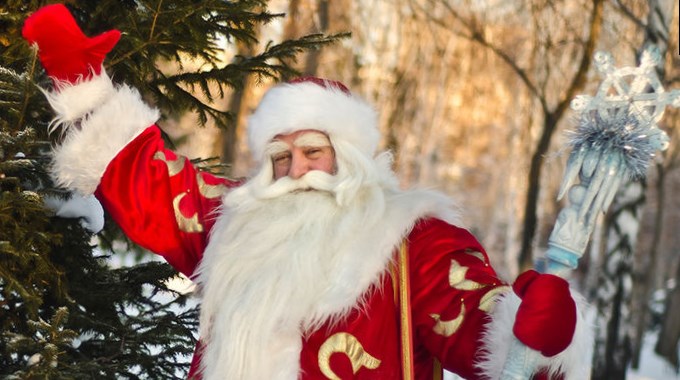Everybody knows him as a kind fairy-tale character that gives gifts to the children and lights fires on a conifer tree. Where is he coming from and how he differs from the western Santa?
Upon a time, even before emergence of Christianity in Rus, people believed that familiar spirits protect their generation, care for the litter of cattle and fair weather. Therefore to award them for their care, every winter people gave them the gifts. On the eve of a holiday the rural youth put on masks, everted sheepskin and they were going door to door and caroling. (However, in different regions there were individual features of going a-shroving). Owners presented food to going a-shroving. The sense exactly lied in the fact that going a-shroving posturized the Kachinas that received an award for incessant care over indwellings. Among going a-shroving there often was one "person" dressed most terribly. Generally he was forbidden to speak. It was the oldest and most menacing spirit; he was often named just "Ded". It may be well be that this is a prototype of the modern Ded Moroz.
But today he, of course, became kinder and does not come for gifts, but brings them. With adoption of Christianity pagan rites were transformed, and wassail-singers became carollers. The great-great-grandfather of the modern Russian Ded Moroz was the hero of Russian folk tales Jack Frost (Morozko) or Moroz krasnyj nos, the owner of weather, winter and frost. Initially he was called Ded Treskun and he was represented as a little old man with a long beard and severe as the Russian frosts temper. From November to March Ded Treskun was an absolute master on the earth. Even the sun was afraid of him! He was married to the very wicked person – Winter (Zima). Ded Treskun or Jack Frost (Morozko) were also identified with the first month of year – the middle of winter – January
In the Russian fairy tales Ded Moroz is represented as eccentrically, strict, but fair spirit of winter.
Ded Moroz was represented as the gray-haired old man with a beard to a floor in a long thick fur coat, felt boots, a cap, mittens, and with a staff by which he froze people.
It is difficult to say unambiguously where the Russian Ded Moroz lives ,as there is a lot of legends. Somebody takes up the position that Ded Moroz is from the North Pole, others says – he is from Lapland. One thing is clear, that Ded Moroz lives somewhere on far north where it is winter all the year. Though in the fairy tale by V.F. Odoevsky "Moroz Ivanovich" Moroz krasnyj nos on spring gets across a well where "it’s freezing in summer too". After construction of the tower of Ded Moroz in Veliki Ustyug the issue for Russians was resolved unambiguously.
Later a granddaughter of Ded Moroz named Snegurka or Snegurochka appeared near Jack Frost. She was the heroine of many Russian fairy tales, the snow girl. And Ded Moroz changed too: he began to bring gifts to children on New Year's Eve and made the desires come true. The image of Snegurochka is unique for the Russian culture. In the western New Year's and Christmas mythology there are no female characters.

The figure of Santa Claus image was invented in 1823 by the seminar teacher Klement Klark Mur who on the Christmas's eve read to his wife and children the poem "Christmas on a Threshold, or Santa Claus's Visit" written by him. He represented Santa Claus as a kind elf that comes on eight deer and gets into the house through a flue
The first image of Santa Claus was drawn in 1862 by the caricaturist Thomas Nast. During 24 years he was drawing it for a cover of the popular magazine "Harper's weekly". The artist lodged Claus on the North Pole (but not in Lapland). Santa Thomas Nast had one shortcoming - it was black-and-white.
The red fur coat was presented to the fantastic grandfather in 1885 by the publisher Luís Prang. He transferred the Victorian tradition of the Christmas greeting cards executed in the equipment of a color lithograph to America. In such a way Santa Claus changed furs in which he was dressed up by Nast, on solid bright red attire.
At last, in 1930 the Coca-Cola company invented a cunning advertizing gimmick so that people could not forget about their production neither in summer, nor in winter – the artist from Chicago Hehddon Sandblom represented Santa Claus in red-white colors of Coca-Cola. So the modern image of Santa Claus where he was represented not as the elf of Clement Moore, but as a giant was born. Sandblom entered into his team the ninth deer named Rudolf. The Santa's prototype for Sandblom was his friend and neighbor Lu Prentice.
And who are the Saint Nicholas or Saint Claus?
Nikolaos the Wonderworker lived in 4th century. Since the early childhood he differed with neighbourly charity, and having become the bishop, he donated alms in every way, and always made it secretly – enclosing gifts in windows. Once, wishing to help a penurious family where there were three daughters and which father decided to sell them for fornication because of poverty , Saint Nicholas delivered him three sacks with gold coins that allowed father to collect corbeille to daughters and bestow them in marriage.
According to a Catholic legend, once all windows in the house appeared to be locked, and the Saint delivered money in a pipe. The legend narrates that gold coins got to the drying socks hanging near the oven. Therefore today Catholics enclose gifts in socks hanging up at a fireplace.
Orthodox Christians esteem Nikolaos the Wonderworker not only for his generosity and love to almsmen, but also for his uncompromising stand in fight against heresies, and numerous wonders that he made both at life and after his death. At various times he saved maligned and wrongfully convicted from death. Saint Nikolay was considered as the defender by seamen and fishermen and also by Russian merchants. Russian people always recoursed to a prayer to the prelate Nikolay and received a fast consolation in their needs.
The story written Lives of Saints about disposal of the son Agrikov from Saracenic captivity is widely known. And ancient Kiev cherishes the memory of wonderful rescue of the drowned baby by the prelate. The great wonder-worker, having heard the mournful prayers of parents who have lost their only heir took out the baby from water at night, recovered him and put him on choirs of the temple of Saint Sofia behind his wonder-working image. Here the saved boy was found in the morning by happy parents who glorified Saint Nicholas with a great number of the people.
On the St Nicholas the Wonderworker day that Orthodox Christians celebrate on 19-th of December and Catholics - on 6-th of December, appeared the tradition to give presents for obedient children in honour of the prelate. A large number of the ancient Western European cards representing Saint Nicholas in clothes of Catholic bishop with the bag full of toys surrounded by a crowd of children remained up to now. In the process of society laicization this tradition lost its popularity, and the role of the generous donator smoothly passed to the quite secular Santa Claus.
